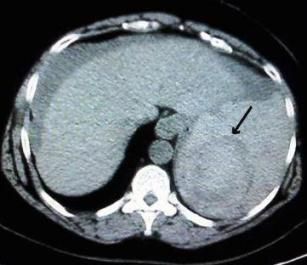Splenic Rupture After Screening Colonoscopy
Splenic rupture during colonoscopy is rare but can be lethal; presentation includes severe abdominal pain and hemodynamic instability.

A 52-year-old obese woman presented to the emergency department for severe diffuse abdominal pain, nausea, and vomiting of 12 hours’ duration. She reported undergoing screening colonoscopy the day before. The patient appeared pale and was hypotensive with tachycardia (heart rate, 120 beats/min; systolic blood pressure, 70 mm Hg). A complete blood cell count revealed hemoglobin of 8.6 mg/dL and hematocrit of 26.1%. CT scan of the abdomen and pelvis revealed a ruptured spleen with a hematoma surrounded by a moderate to large amount of free fluid (Figure).
The patient was admitted after being stabilized with isotonic intravenous fluids and blood transfusion. She underwent splenectomy. Her condition improved and she was discharged in good condition after 2 days.
Discussion
Colonoscopy is used for diagnosis and treatment of a multitude of GI and surgical conditions. Splenic injury after colonoscopy is a serious complication, yet its true incidence is largely unknown; the current literature consists of case reports. The first known case report of splenic rupture as a possible complication of colonoscopy is attributed to Wherry and Zhener,1 in 1974. Fewer than 70 cases have been reported in literature since then.2
There are many large published series reports of colonoscopies3-7 that include as many as 82,0004 procedures. The complication rate is very low, with hemorrhage occurring most often (1% to 2%) followed by colonic perforation (0.1% to 0.2%).8 Specific data are elusive, but one estimate puts the incidence of colonoscopy-associated splenic injury at 0.004%.9 Although it is rare, splenic rupture after colonoscopy may become lethal. Splenectomy is typically required.
Severe abdominal pain following colonoscopy, especially within 24 hours following the procedure, warrants a high index of suspicion for splenic injury, after perforation and hemorrhage have been excluded. Hemodynamic instability is almost universally seen.8
Levine and Wetzel10 proposed 2 theories for the probable cause of splenic injury during colonoscopy. Difficult scope advancement through the colon may impart direct injury to the spleen during passage through the splenic flexure. Dense adhesions between the colon and spleen from previous surgery or disease may result in tearing of the splenic capsule as the colonoscope is passed through the colon.10 Patients with intraperitoneal adhesions or with underlying splenic pathology are at greater risk for splenic injury; however, this complication can occur in healthy individuals.8
The incidence of splenic rupture after colonoscopy may be higher than suggested in the literature. The endoscopist should suspect splenic injury after colonoscopy in a patient who develops abdominal pain and tenderness without any evidence of bowel perforation or rectal bleeding with or without hemodynamic instability.
An important point for primary care physicians is illuminated by one author’s search of the literature, which revealed that many of the cases reported were diagnosed relatively late-up to 10 days post-procedure.8 The most likely reason cited is a heretofore low index of suspicion for the injury.8 One multicenter search that identified 11 adults with symptomatic splenic injury related to colonoscopy reported no immediate complications at optical colonoscopy and only 1 case of hemodynamic instability immediately post-procedure.11 In the other 10 patients, presentation was delayed from 8 hours to 8 days (mean, 2.1 days). CT was diagnostic for splenic injury with subcaspular and/or perisplenic hematoma in all 10 CT cases.11
Recognition of patient factors that may predispose to splenic injury before the procedure, awareness of the small but real potential for injury and extended follow-up after colonoscopy, and knowledge of typical presenting signs and symptoms among members of the attending multidisciplinary health care team are all essential to prevent morbidity and mortality as use of screening colonoscopy continues to grow.
References
1. Wherry DC, Zehner H Jr. Colonoscopic fibroptic colonoscopic approach to the colon and polypectomy. Med Ann DC. 1974;43:189-192.
2. Peterson CR, Adamsen S, Gocht-jensen P, et al. Splenic injury after colonoscopy. Endoscopy. 2008;40:76-79.
3. Levin TR, Zhao W, Conell C, et al. Complications of colonoscopy in an integrated health care delivery system. Ann Intern Med. 2006;145:880-886.
4. Sieg A, Hachmoeller-Eisenbach U, Eisenbach T. Prospective evaluation of complications in outpatient GI endoscopy: a survey among German gastroenterologists. Gastrointest Endosc. 2001;53:620-627.
5. Smith LE. Fiberoptic colonoscopy: complications of colonoscopy and polypectomy. Dis Colon Rectum. 1976;19:407-412.
6. Ong E, Bhmler U, Wurbs D. Splenic injury as a complication of endoscopy: two case reports and a literature review. Endoscopy. 1991;23:302-304.
7. Jentschura D, Raute M, Winter J, et al. Complications in endoscopy of the lower gastrointestinal tract: therapy and prognosis. Surg Endosc. 1994;8:672-676.
8. Sarhan M, Ramcharan A, Ponnapalli S. Splenic injury after elective colonoscopy. JSLS. 2009;13:616-619.
9. de Vries J, Ronnen HR, Oomen AP, Linskens RK. Splenic rupture following colonoscopy, a rare complication. Neth J Med. 2009;67:230-233.
10. Levine E, Wetzel LH. Splenic trauma during colonoscopy. AJR Am J Roentgenol. 1987;149:939-940.
11. Fishback SJ, Pickhardt PJ, Bhalla S, et al. Delayed presentation of splenic rupture following colonoscopy: clinical and CT findings. Emerg Radiol. 2011;18:539-544.
Clinical Tips for Using Antibiotics and Corticosteroids in IBD
January 5th 2013The goals of therapy for patients with inflammatory bowel disorder include inducing and maintaining a steroid-free remission, preventing and treating the complications of the disease, minimizing treatment toxicity, achieving mucosal healing, and enhancing quality of life.